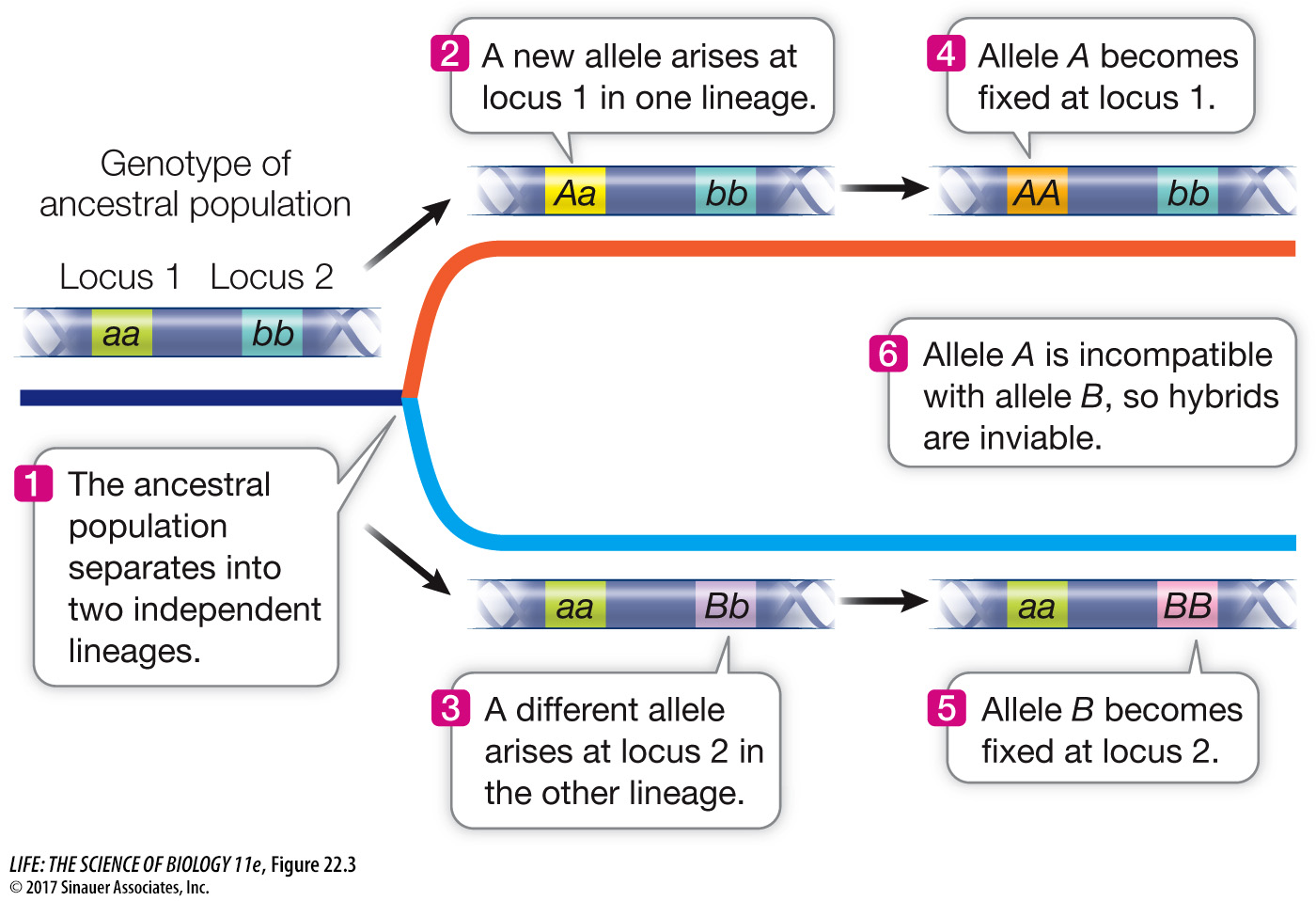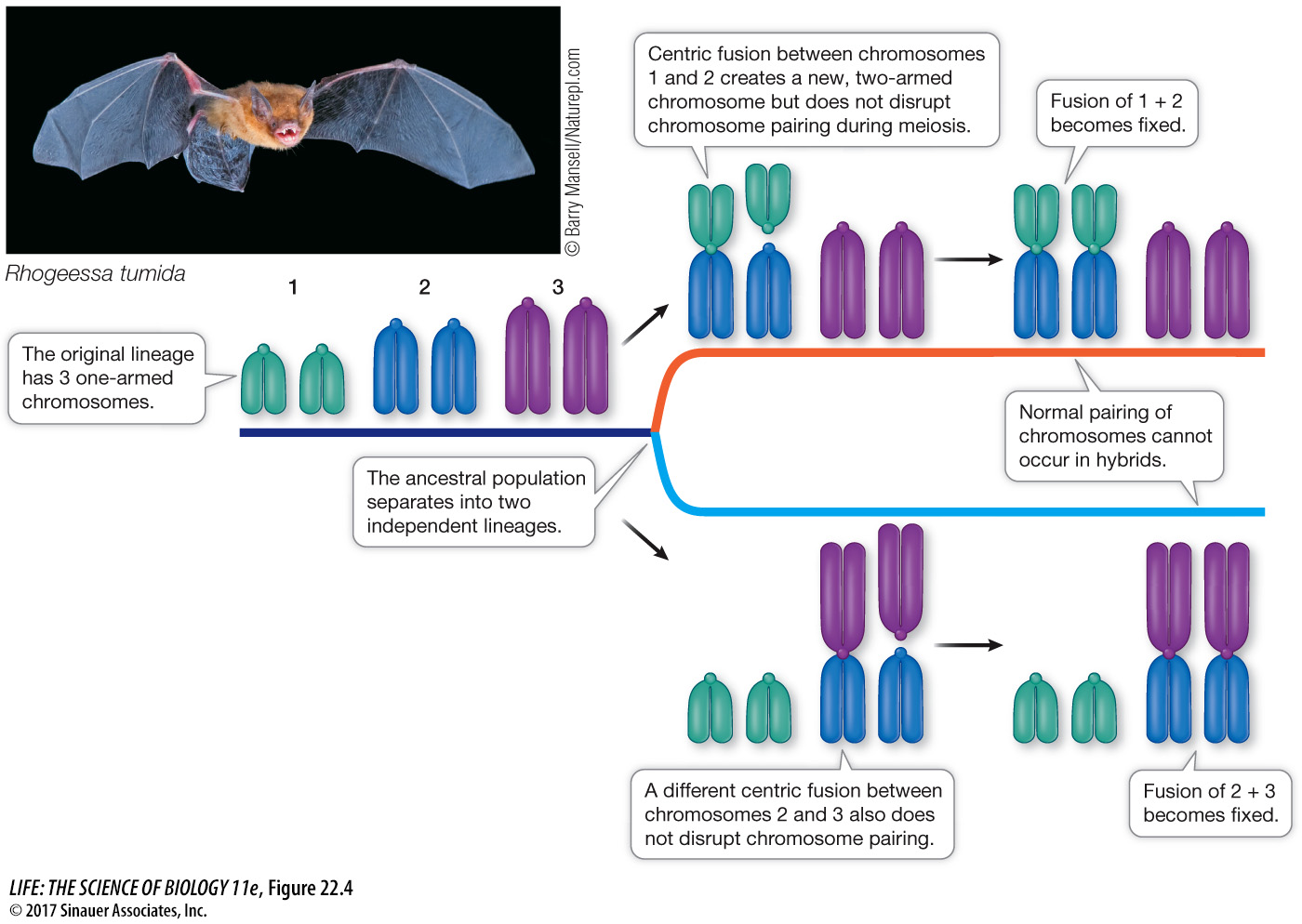Incompatibilities between genes can produce reproductive isolation
If a new allele that causes reproductive incompatibility arises in a population, it cannot spread through the population because no other individuals will be reproductively compatible with the individual that carries the new allele. So how can one reproductively cohesive lineage ever split into two reproductively isolated species? Several early geneticists, including Theodosius Dobzhansky and Hermann Joseph Muller, developed a genetic model to explain this apparent conundrum (Figure 22.3).

Figure 22.3 The Dobzhansky–Muller Model In this simple two-locus version of the model, two lineages from the same ancestral population become physically separated from each other and evolve independently. A new allele becomes fixed in each descendant lineage, but at a different locus. Neither of the new alleles is incompatible with the ancestral alleles, but the two new alleles in the two different genes are incompatible with each other. Thus the two descendant lineages are reproductively incompatible.
Activity 22.1 Speciation Simulation
The Dobzhansky–Muller model is quite simple. First, assume that a single ancestral population is subdivided into two daughter populations (by the formation of a new mountain range, for instance), which then evolve as independent lineages. In one of the descendant lineages, a new allele (A) arises and becomes fixed (see Figure 22.3). In the other lineage, another new allele (B) becomes fixed at a different gene locus. Neither new allele at either locus results in any loss of reproductive compatibility. However, the two new forms of these two different genes have never occurred together in the same individual or population. Recall that the products of many genes must work together in an organism. It is possible that the new protein forms encoded by the two new alleles will not be compatible with each other. If individuals from the two lineages come back together after these genetic changes, they may still be able to interbreed. However, the hybrid offspring may have a new combination of genes that is functionally inferior, or even lethal. This will not happen with all new combinations of genes, but over time, isolated lineages will accumulate many allele differences at many gene loci. Some combinations of these differentiated genes will not function well together in hybrids. Thus genetic incompatibility between the two isolated lineages will develop over time.
Many empirical and experimental examples support the Dobzhansky–Muller model. This model works not only for pairs of individual genes but also for some kinds of chromosomal rearrangements. Bats of the genus Rhogeessa, for example, exhibit considerable variation in centric fusions of their chromosomes. The chromosomes of the various species contain the same basic chromosomal arms, but in some species two acrocentric (one-armed) chromosomes have fused at the centromere to form larger, metacentric (two-armed) chromosomes. A polymorphism in centric fusion causes few, if any, problems in meiosis because the respective chromosomes can still align and assort normally. Therefore a given centric fusion can become fixed in a lineage. However, if a different centric fusion becomes fixed in a second lineage, then hybrids between individuals of each lineage will not be able to produce normal gametes in meiosis (Figure 22.4). Most of the closely related species of Rhogeessa display different combinations of these centric fusions and are thereby reproductively isolated from one another.

Figure 22.4 Speciation by Centric Fusion In this chromosomal version of the Dobzhansky–Muller model, two independent centric fusions of one-armed chromosomes occur in two sister lineages. Neither centric fusion by itself results in difficulties at meiosis, whether the fusion is found in just one or in both pairs of chromosomes. After fixation of the different fusions in each lineage, however, F1 hybrids between the two lineages are sterile, because the three different chromosomes involved in these centric fusions cannot pair normally at meiosis in hybrids. Most of the species in the bat genus Rhogeessa differ from one another by such centric fusions.

